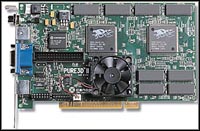At a first glance, the attractive Pure3D II box doesn't seem big enough to hold a Voodoo2 card, since the Creative Labs and Diamond Multimedia Boxes just about twice the size in length. In spite of its small size, the Pure3D II Box does hold much more than meets the eye.
| Included in the Pure3D II package is the board itself, which is a full inch shorter than the reference Voodoo2 design making it a better fit for Baby AT motherboards as well as motherboards with cramped ATX layouts, an Installation Guide, RCA/S-Video TV-Out cables, audio cables, an external Pass Through Cable, a 6" Scan Line Interleave interface cable for connecting 2 Pure3D II's together, and a Pure3D II Drivers/Utilities CD-ROM. |  |
| For the most part, a package like that is fairly standard for a Voodoo2 card, however Canopus paid great attention to all facets of the overall experience users would have with the Pure3D II. | |
Looking at the Pure3D II Board, the biggest difference, aside from the shorter length, is the presence of the Cooling Fan over the Voodoo2 chip on the card. While it would have been more intelligent to place a Heatsink on the chip with a fan on top of that, Canopus chose to include a fan to help cool the chip which is prone to produce incredible amounts of heat, for a 3D Accelerator that is. The fan is powered by a 2-pin Power Supply connector on the Pure3D II board, and spins up to nothing more than a quiet purr during normal operation. Canopus claims that it helps enable users to overclock their boards to 100MHz from the normal 93MHz Memory Clock of the Voodoo2 chipset, however we have already proven that older cards, such as the Creative Labs Graphics Blaster Voodoo2, will make it up to 100MHz without the use of any cooling devices. The fan is basically added security for overclockers, it is nice to know that Canopus had some insight to take the initiative to equip their Voodoo2 board with some sort of active cooling.
Another unique little addition Canopus made to the reference design called for a Green LED Light which illuminates when the board it operational. This feature is supposed to help diagnose problems with the card when troubleshooting, essentially telling you if the card is doing its duty or not. However for the most part, it can be considered an extra 30 cents of difference between the Pure3D II and a Creative Labs Voodoo2 card.
Due to the shorter length of the Pure3D II, the SLI Connector is centrally oriented on the left hand side of the card. To compensate, Canopus has included a massive (compared to the 3Dfx recommended standard) 6" SLI cable for connecting two Pure3D II's together. For those of you that aren't familiar with the term, Scan Line Interleave, is a special operation mode the Voodoo2 chipset supports allowing two Voodoo2 boards to operate in a process similar to a parallel processing environment. In SLI Mode one Voodoo2 card would handle all of the odd scan lines (your screen is divided into a number of horizontal scan lines which are placed on the screen by your picture tube) while the other card handles all even scan lines.
The Pure3D II is a 3D add-on card, which interfaces through your current AGP/PCI 2D or 2D/3D Video Card using an external Pass Through Cable. Provided that you don't have a Total3D 128V from Canopus, in which case you can use an Internal Pass Through Cable to connect the two cards, you can make use of the extremely flexible external cable provided by Canopus. Unlike other Voodoo2 boards, the Canopus Pure3D II's pass through cable isn't simply a VGA to VGA connector, to conserve space on the interface panel Canopus used a proprietary connector to connect your existing graphics card to the Pure3D II. This supplied pass through cable is not only very flexible, as mentioned above, but it also doesn't seem to cause any image deterioration even at higher desktop resolutions.
Why would Canopus be interested in conserving space on the interface panel of the Pure3D II? In order to make room for the RCA and S-Video output jacks that they have chose to put on the card, making this Voodoo2 card a bit more than the competition can offer. The quality of the Pure3D II's TV-Out is pretty much standard as far as Canopus is concerned, if you are feeling limited by the size of your 14 or 15" monitor then the ability to use a larger TV for your Quake-ing is a definite plus. If you happened to be blessed by the presence of a 19" or larger monitor, then the TV-Out will probably serve you no good as the quality of your PC's monitor is clearly much more crisp and clear. Either way, the Pure3D II allows you to achieve the previously unachievable with a Voodoo2 based 3D accelerator.










0 Comments
View All Comments